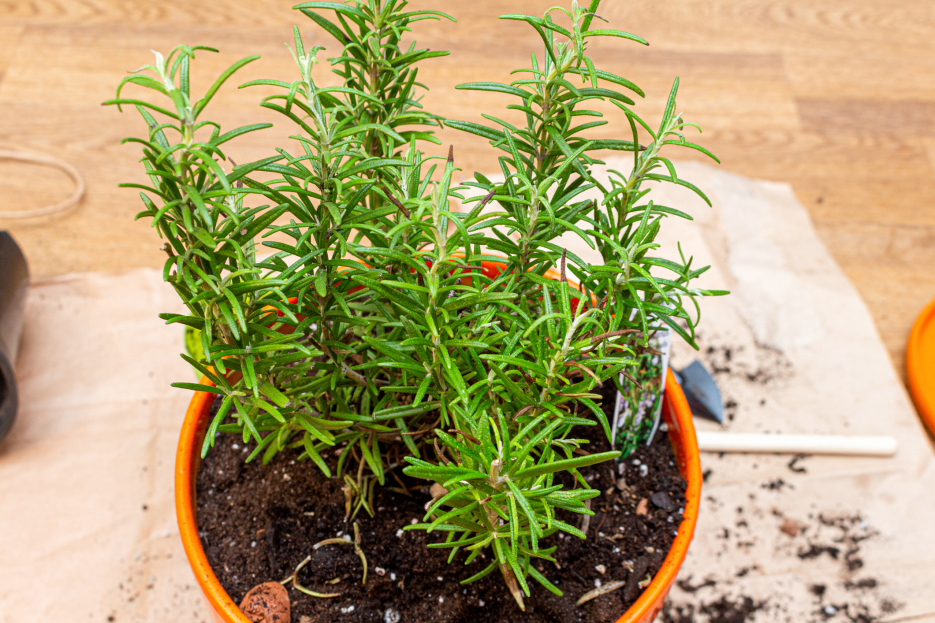
Rosemary is a fragrant, evergreen herb widely used for culinary, medicinal, and ornamental purposes. Its needle-like leaves are rich in aromatic oils that enhance many dishes, making it a must-have for herb gardens. Here’s how to care for your rosemary plant.
Rosemary thrives in full sun, requiring at least 6-8 hours of direct sunlight per day. It prefers bright, sunny conditions, so if you’re growing it indoors, place it near a south-facing window or under a grow light. Outdoors, choose a spot that gets plenty of sunlight, as insufficient light can cause the plant to become leggy and weak.
Rosemary doesn’t require heavy feeding. A light application of an organic, balanced fertilizer in the spring should be sufficient. Too much fertilizer can reduce the concentration of essential oils in the leaves, diminishing its flavor and fragrance. If growing them in containers, you can use a diluted liquid fertilizer every 4-6 weeks during the growing season.
Rosemary is drought-tolerant and prefers to dry out between waterings. Water when the top inch of soil feels dry, ensuring that the soil is well-drained to avoid root rot. Overwatering is one of the most common mistakes when growing rosemary, so be careful not to keep the soil consistently wet. They do better with deep, infrequent watering than with frequent shallow watering.
Rosemary grows best in well-draining soil with a slightly alkaline pH, around 6.0-7.5. A sandy or loamy soil mix works well, especially if amended with compost to improve fertility. When grown in containers, choose a pot with good drainage, and use a potting mix designed for Mediterranean plants or herbs. Re-pot them every 1-2 years, choosing a slightly larger container to accommodate its root growth.
Rosemary prefers warm climates and thrives in temperatures between 60°F and 80°F (16°C to 27°C). It can tolerate temperatures down to 20°F (-6°C), but in regions with harsh winters, it’s best to grow them in pots so you can bring it indoors during colder months. In very hot climates, provide some afternoon shade to protect the plant from intense heat.
Rosemary prefers low to moderate humidity and does well in drier environments. It does not tolerate high humidity well, as this can promote fungal diseases. Indoors, make sure the air circulates freely around the plant to prevent humidity from building up. Outdoor plants usually get adequate airflow, but avoid overcrowding them.
Rosemary can be propagated by cuttings, division, or seeds. However, cuttings are the most reliable method for home gardeners.
Take a 4-6 inch cutting from the tip of a healthy stem, strip off the lower leaves, and place the cutting in water or moist soil. After a few weeks, the cutting will develop roots and can be transplanted into the garden or a container. Seeds are slow to germinate and grow, so they are less commonly used.
Rosemary benefits from regular pruning to encourage bushier growth and prevent the plant from becoming too woody. Trim back about one-third of the plant in early spring to shape it and remove any dead or damaged branches. During the growing season, harvest them by cutting stems as needed, but avoid removing more than one-third of the plant at any time. This ensures the plant remains healthy and continues to produce new growth.
Rosemary is relatively pest-resistant but can sometimes be affected by aphids, spider mites, or whiteflies. These pests can usually be managed by spraying the plant with water or using organic insecticidal soap. Root rot is the most common issue for them, caused by overwatering or poorly draining soil. Make sure the soil is well-drained and avoid overwatering to prevent fungal diseases like powdery mildew.
Yes, rosemary is non-toxic to cats and dogs. It is safe for pets to consume in small quantities, though large amounts might cause digestive upset. However, rosemary is generally safe to have around animals, and its strong scent may even deter curious pets from nibbling on it.
Rosemary requires at least 6-8 hours of direct sunlight per day to thrive.
Water when the top inch of soil is dry, allowing the soil to dry out between waterings.
Rosemary prefers well-draining, slightly alkaline soil with a pH between 6.0 and 7.5.
Yes, rosemary can be grown indoors if it gets enough sunlight, ideally near a south-facing window or under a grow light.
Rosemary is most commonly propagated from cuttings, which root easily in water or soil.
Rosemary thrives in temperatures between 60°F and 80°F (16°C to 27°C), but can tolerate temperatures as low as 20°F (-6°C).
Regularly trim about one-third of the plant in spring to shape it and encourage new growth. During the growing season, harvest stems as needed.
Rosemary can occasionally attract aphids, spider mites, and whiteflies. Root rot is the most common issue caused by overwatering.
Rosemary doesn’t require much fertilizer. A light application of organic fertilizer in spring is usually sufficient.